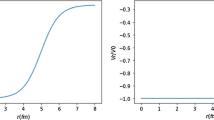Summary
AλΦ 4 solitary-wave propagator, a propagator constructed from exact particular solutions (solitary-wave solutions) to a nonlinear field equation is used in the usual derivation of a two-nucleon potential. The field equation is a Klein-Gordon equation modified by the addition of a cubic self-interaction term (λΦ 3) and describes massive spinless persistently self-interacting systems. The solitary-wave propagator has poles at integral multiple [(2n + 1)m] mass states. Contributions from these poles to the two-nucleon potential in co-ordinate space appear as a superposition of Yukawa and exponential terms with residues that depend on the self-interaction coupling constant (λ). In the limit of vanishing λ, the solitary-wave exchange potential (SWEP) reduces to the standard OPEP. For a two-nucleon in ans-state, the SWEP is very strongly attractive at intermediate ranges (0.5 ≲mr ≲ 1.5) and smoothly gives rise to a repulsive core at very short ranges (mr ≲ 0.5). At very large ranges (mr ≳ 1.5) the SWEP approaches the OPEP tail. Overall, the SWEP exhibits characteristic features of OBEP and phenomenological potential models, but requires only a small number of parameters even in contrast to OBEP.
Riassunto
Si usa un propagatore d’onda solitariaλΦ 4, un propagatore costruito da soluzioni particolari esatte (soluzioni dell’onda solitaria) all’equazione di campo nonlineare nella deduzione usuale di un potenziale a due nucleoni. L’equazione di campo è un’equazione di Klein-Gordon modificata con l’aggiunta di un termine di autointerazione cubico (λΦ 3) e descrive sistemi persistentemente autointeragenti senza spin con massa. Il propagatore d’onda solitaria ha poli a stati di massa multipli interi [(2n + 1)m]. Contributi da questi poli al potenziale a due nucleoni nello spazio delle coordinate appaiono come una sovrapposizione di termini di Yukawa ed esponenziali con residui che dipendono dalla costante di accoppiamento dell’autointerazione (λ). Nel limite diλ tendente a zero, il potenziale di scambio dell’onda solitaria (PSOS) si riduce al normale OPEP. Per un dinucleone in uno statos il PSOS è fortemente attrattivo a intervalli intermedi (0.5 ≲mr ≲ 1.5) e dà origine dolcemente a un nucleo repulsivo in intervalli molto piccoli (mr ≲ 0.5). Per intervalli molto grandi (mr ≳ 1.5) il PSOS approccia la coda di OPEP. In complesso, il PSOS mostra caratteristiche particolari di OBEP e modelli di potenziale fenomenologici, ma richiede solo un piccolo numero di parametri anche in contrasto con l’OBEP.
Реэюме
При обычном выводе двух-нуклонного потенциала испольэуется пропагатор λФ4 обособленной волны, пропагатор, сконструированный иэ точных частных рещений (рещений для обособленных волн) уравнения нелинейного поля. Рассматриваемое уравнение поля представляет уравнение Клейна-Гордона, моди-фицированное эа счет добавления кубического члена собственного вэаимодействия (λФ3), и описывает массивные бесспиновые системы с неэатухаюшим собственным вэаимодействием. Пропагатор обособленной волны имеет полюса при массовых состояниях кратных [(2п+ 1)m]. Вклады от зтих полюсов в двух-нуклонный потенциал в координатном пространстве воэникают как суперпоэиция потенциала Юкавы и зкспоненциальных членов с вычетами, которые эависят от константы собственного вэаимодействия (А). В пределе, когда X стремится к нулю, потенциал с обменом обособленной волной сводится к стандартному потенциалу с обменом одним пио-ном. Для двух-нуклонного потенциала в "-состоянии, потенциал с обменом обо-собленной волной характериэуется сильным притяжением в промежуточной области (0.5 ≲ тг ≲1.5) и плавно переходит в отталкиваюший остов на очень малых рас-стояниях (тг ≲ 0.5). При очень больщих расстояниях (тr ≲ ] .5) потенциал с обменом обособленной волной аппроксимирует хвост потенциала с обменом одним пионом. Таким обраэом, потенциал с обменом обособленной волной обнаруживает харак-терные особенности потенциала с обменом одним боэоном и моделей феномено-логических потенциалов, но требует очень малого количества параметров, даже по сравнению с потенциалом с обменом одним боэоном.
Similar content being viewed by others
Literatur
P. B. Burt:International Symposium on Mathematical Physics Proceedings, University of Texas, Austin, November 18–22, 1974, to be published.
P. B. Burt:Lett. Nuovo Cimento,13, 26 (1975).
P. B. Burt andM. Sebhatu:Lett. Nuovo Cimento,13, 104 (1975).
G. F. Chew andL. Koplik:Phys. Lett.,48 B, 221 (1974);Nucl. Phys.,79 B, 365 (1974).
P. B. Burt andJ. L. Reid:J. Phys. A,6, 1388 (1973).
P. T. Matthews:Phil. Mag.,41, 185 (1950).
L. I. Schiff:Phys. Rev.,86, 856 (1952);B. J. Malenka:Phys. Rev.,86, 68 (1952);E. M. Henley:Phys. Rev. 87, 42 (1952).
J. Glimm andA. Jaffe:Quantum Field Theory Models (New York, N. Y., 1970).
D. Bessis, G. Turchetti andW. Wortman:Nuovo Cimento,22 A, 157 (1974).
M. J. Moravcsik:Rep. Prog. Phys.,35, 587 (1972).
R. V. Reid:Ann. of Phys.,50, 411 (1968);C. W. Bressel, A. K. Kerman andR. Rouben:Nucl. Phys.,124 A, 624 (1969);H. A. Bethe andM. B. Johnson:Nucl. Phys.,230 A, 209 (1974);R. DeTourreil andD. W. Sprung:Nucl. Phys.,201 A, 193 (1974).
K. Erkelenz, K. Holinde andR. Machleidt:Phys. Lett.,49 B, 209 (1974).
P. Söding, J. Bartels, A. Barbaro-Galtieri, J. E. Enstrom, T. A. Lasinski, A. Rittenberg, A. H. Rosenfeld, T. G. Trippe, N. Barashi-Schmidt, C. Bricman, V. Chaloupka andM. Roos:Phys. Lett.,39 B, 1 (1972);T. A. Lasinski, A. Barbaro-Galtieri, R. L. Kelly, A. Rittenberg, A. H. Rosenfeld, T. G. Trippe, N. Barash-Schmidt, C. Bricman, V. Chaloupka, P. Söding andM. Roos:Rev. Mod. Phys. Suppl.,45, part II (1973).
P. B. Burt andJ. L. Reid:J. Phys. A,6, 1388 (1973);J. L. Reid andP. B. Burt:Journ. Math. Anal. Appl.,47, 520 (1974).
P. B. Burt:Phys. Rev. Lett.,32, 1080 (1974).
J. D. Bjorken andS. D. Drell:Relativistic Quantum Fields (New York, N. Y., 1965).
J. S. Curiale:Nuovo Cimento,22 A, 527 (1974).
L. Hulthén andM. Sugawara:Encyclopedia of Physics, Vol.39 (Berlin, 1959), p. 1.
Author information
Authors and Affiliations
Additional information
To speed up publication, the author of this paper has agreed to not receive the proofs for correction.
Place where most of the work was done as part of Ph. D. dissertation.
Present address.
Rights and permissions
About this article
Cite this article
Sebhatu, M. Modifications of a two-nucleon potential due to solitary waves in self-interacting spin-zero meson fields. Nuov Cim A 33, 568–578 (1976). https://doi.org/10.1007/BF02729872
Received:
Published:
Issue Date:
DOI: https://doi.org/10.1007/BF02729872




